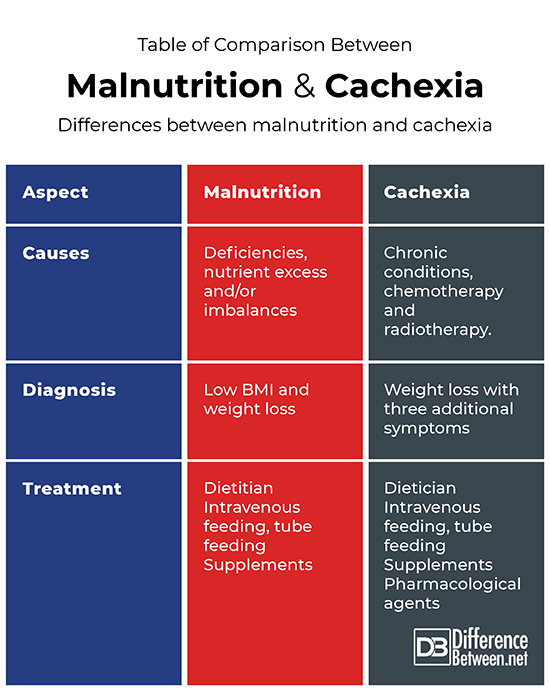Difference Between Cachexia and Malnutrition

Cachexia and malnutrition are both in relation to the status of nutrition in a person. Despite the two conditions being closely linked, each condition is clinically independent and the two cannot be likened to one another. Malnutrition primarily focuses on the nutrition, more specifically the lack or excess thereof, in a patient. Cachexia, on the other hand, focuses on the nutritional aftermath or accompanying effects in relation to underlying systematic disease or chronic conditions in patients.

Definition
Malnutrition refers to deficiencies, excesses or imbalances found in an individual’s intake of energy and/or nutrients. This is a broader term is commonly used only to refer to undernutrition, but it also includes overnutrition. The term “malnutrition” includes two broader groups of conditions as follows:
“Undernutrition”:
- including stunting (which refers to low height measurements in relation to age)
- Wasting (which refers to low weight measurement in relation to height)
- Underweight (which refers to low weight in relation to age)
- Micronutrient deficiencies or insufficiencies (which refers to a lack of vitamins and minerals of importance)
“Overweight, obesity and diet-related noncommunicable diseases”
- This includes conditions such as heart disease, stroke factors, diabetes, and various cancers.
Cachexia is defined as a complex metabolic syndrome and is associated with underlying illness. This condition is characterized by the loss of muscle with or without loss of fat. Cachexia is also known or referred to as “wasting syndrome”.
The most prominent clinical feature of this condition is weight loss in adult patients and failure to grow in children. Other conditions often associated with cachexia are anorexia, inflammation in the body, an increase in muscle protein breakdown, and insulin resistance.
Symptoms and Clinical Presentation
Malnutrition often presents through various signs and symptoms. These are often as follows:
- An increases frequency of infections
- Loss in appetite
- Fatigue and feeling lethargic
- Increased irritability
- Changes in mood status (for example, cases of depression)
- Poor weight gain despite attempts to improve weight status
The signs and symptoms most commonly seen upon clinical presentation of this condition are as follows:
- Swelling
- Fatigue and feeling lethargic
- Muscle wasting (specifically skeletal muscle type)
- Decreased appetite
- Unintentional/involuntary weight loss
Causes
Malnutrition is caused by types of deficiencies, excess and/or imbalances in the intake of energy and/or nutrients in an individual.
Cachexia is caused by conditions such as dysphagia, cancers, HIV, tuberculosis, heart failure, stroke, and others. Additional causes are treatments such as chemotherapy and radiotherapy.
Diagnosis
The diagnosis of malnutrition is based on the following:
- Clinical presentation/picture
- BMI <18.5 kg/m2
- Weight loss of more than 10%
- Weight loss of more than 5% over the last three months in combination with a BMI <20 in 70-year-olds and under, or BMI <22 in 79-year-olds and above.
The diagnosis of cachexia is based on the following:
- Weight loss of 5% or more in a year or less in accompaniment of underlying illness WITH three of the following symptoms:
- Decrease in muscle strength
- Increased fatigue
- Anorexia
- Low fat-free mass
- Abnormal biochemistry test results (such as inflammatory markers, blood cell presence)
Treatment
Treatment for malnutrition generally includes consultation with a registered and qualified dietician, intravenous feeding and/or tube feeding (via nasogastric tube or abdominal tube), and the administration of supplements (such as vitamins).
Treatment options specifically for cachexia are limited but also include generally includes consultation with a registered and qualified dietician, intravenous feeding and/or tube feeding, administration of supplements (such as vitamins). The treatment limitations in cachexia includes the issue that the general treatment does not treat or correct the underlying disease and problem. There are certain medications and promising pharmacological agents, but effectiveness of these have not yet been proven. Treatment strategies by healthcare professionals for cachexia aim to target skeletal muscle wasting in the presence of an adequate nutritional state.
Table of comparison between malnutrition and cachexia

Summary
In many ways, cachexia and malnutrition are similar. They present in a similar manner, but a key distinguishing factor in cachexia is the underlying systemic disease. The diagnostic criteria between the two differ slightly, but that is of little importance clinically speaking. In both cachexia and malnutrition, clinical intervention in terms of diagnosis and treatment should take place as soon as possible, as this is the best way to improve the rate of survival in patients.
FAQ
What is the difference between cachexia and starvation?
Cachexia is a syndrome referring to malnutrition and occurs as a result of severe systemic disease. Starvation is caused by a lack of food and occurs as a result of social circumstance and/or mental illness.
What is the difference between cachexia and anorexia?
Both in relation to poor nutrition, cachexia occurs in the background of a systemic disease whereas anorexia refers to the lack or loss of appetite. Anorexia Nervosa on the other hand, is a mental disorder causes the obsession with weight and what is eaten and is characterized by a distorted body image with an unwarranted fear of being overweight.
What is cachexia malnutrition?
Cachexia malnutrition is also known as “wasting syndrome”, is the progression condition of unintentional (or involuntary) weight loss of more than 10% of the baseline body weight in the setting of an underlying systemic disease or chronic infection.
What defines cachexia?
Cachexia is typically defined by muscle loss and the presence of a systemic disease in combination with signs of malnutrition. It is also characterized and defined by the loss of muscle with or without the loss of fat mass.
- Difference Between a Cochlear Implant and Normal Hearing - October 4, 2022
- Difference Between Obstructive and Restrictive Spirometry - September 11, 2022
- The Difference Between White Box and Black Box Testing - September 11, 2022
Search DifferenceBetween.net :
Leave a Response
References :
[0]Evans, W., Morley, J and Argiles, J. Cachexia: A new definition. Clinical nutrition. 2008, vol. 27, pp. 793-799.
[1]Plank, L and Zhu, C. OR06: Validation of ESPEN Diagnostic Criteria for Malnutrition. Clinical Nutrition. 2016; vol. 35, S3.
[2]Ralston, Stuart., Penman, Ian., Britton, Robert., Strachan, Mark and Hobson, Richard. Davidson's principles and practice of medicine. 2018.
[3]Science Direct: Wasting syndrome. https://www.sciencedirect.com/topics/medicine-and-dentistry/wasting-syndrome
